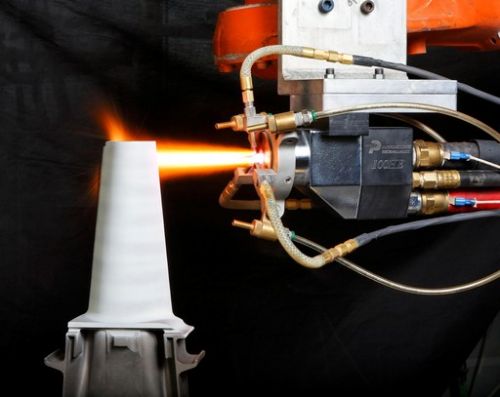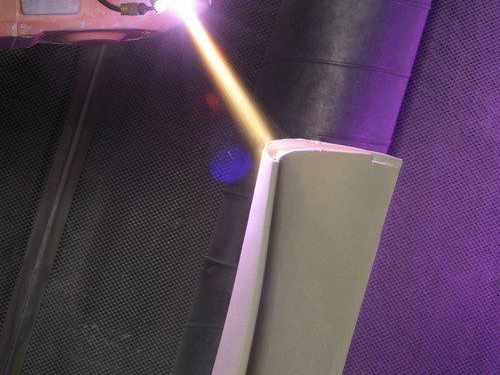In order to maintain sustainable economic development and reduce resource consumption, China began to build a circular economy and a conservation-oriented society in the new century.It puts forward the "4R" development principles (Reduce, Reuse, Recycle, Remanufacture), in which remanufacturing is the most dynamic part of the circular economy.Thermal spraying is a very important technology in the field of remanufacturing.It can be used to prepare many functional coatings such as wear-resisting, corrosion-resisting, heat-insulating, conductive, insulating, anti-wear, lubricating, anti-radiation, etc. It is widely used in modern industry, and has obtained remarkable social and economic benefits.
Thermal spraying material is an important part of thermal spraying technology. It forms the main body of thermal spraying technology together with thermal spraying technology and thermal spraying equipment.Thermal spraying technology has a history of nearly one hundred years since Dr. M.U.Schoop of Switzerland completed the original molten metal spraying device in 1910.During this period, flame spraying, arc spraying, explosion spraying, plasma spraying, supersonic flame spraying, high-speed arc spraying, supersonic plasma spraying and cold spraying technologies successively appeared.Thermal spraying material also develops with the development of equipment and technology.Looking back on history, the development of thermal spraying materials has gone through four stages.
The first stage is characterized by powders and wires with metals and alloys as the main components.The early powder materials were mainly produced by crushing and mixing the primary powder method, while the wire materials were produced by drawing process with a certain diameter of metal wire or alloy wire.Materials are also relatively simple, mainly some metals and their alloys, such as aluminum, zinc, copper, nickel, cobalt and iron.Coating function is relatively simple, is generally anticorrosion and wear resistance, the application surface is relatively small.Only powder flame spraying, wire flame spraying and arc spraying were used for these materials.
The second stage is characterized by self - melting alloys.In the mid-1950s, it was found that in order to solve the problem of massive wear and tear in industrial equipment, it was necessary to improve the process and make a more wear-resistant coating.After several years of efforts, self-melting alloys have been developed and flame spray welding technology, which is known as "hard surface technology".Self-melting alloy is the addition of B, Si, Cr and other elements that can form eutectic alloy with low melting point and antioxidant elements in Ni, Co and fe-based metals. After spraying, reheating and remelting, hard surface coating is obtained.The technology is partly inspired by the welding surfacing process.Because these coatings have high hardness, high metallurgical bonding and good oxidation resistance, so in the wear and oxidation resistance has taken a big step.The appearance of self - melting alloy promotes the thermal spraying technology greatly.Another technological breakthrough in this phase was the advent of plasma spraying equipment.Plasma flame temperature up to 10,000 degrees, can be sprayed almost all materials with a physical melting point.So, some with high wear resistance, high temperature resistant, gas corrosion resistance and heat insulation performance of ceramic and metal ceramic material can be used as thermal spraying material, thermal spraying technology start from simple repair shop into high-tech industries like aviation, aerospace, and solve the problem of material of a lot of headache for metallurgical engineers.Not only did aircraft designers worry that the technology would cause planes to fall from the sky, but since then hundreds of parts have been included in the specifications of an aero engine, requiring thermal spraying to meet the designers' requirements.
The third stage is characterized by the development of composite materials.In the mid-1970s, a series of composite powders and self-bonded primary spraying powders appeared, while in the 1980s, sandwich welding wire as arc spraying material entered the market as the main symbol.Through the "compound" of material composition and structure, the improvement of spraying process and coating performance can be achieved.Nickel-clad aluminum and aluminium-clad nickel composite powder have replaced the traditional Mo silk and improved the adhesion of the bottom layer.Self-adhesive primary powder combines the double functions of primer and working powder to simplify the spraying process.The metal or ceramic that is afraid of oxidation or nitriding is coated by Ni or Co, which not only protects the core component, but also reacts with the core component in the chemical or metallurgical way, giving the coating better performance.Composite materials are not limited to powder, but also in the wire composite spraying wire.Especially filling type composite wire, has begun to enter the market, these composite wire can be used wire flame spraying, but mainly with arc spraying, so that these can only form the original metal-alloy coating process, can be sprayed with ceramic class hard point hard wear-resisting materials, so that the coating application surface greatly expanded.
The fourth stage is characterized by flexible materials and nanomaterials.In order to overcome the disadvantages of powder spraying, it has been a long time to spray powder smelting and rolling into wire rod. However, many materials cannot be rolled into wire rod.After the production of powder core wire, namely powder package in the steel coating for spraying, can be used flame, can also be used for arc spraying.But there are many poor electrical conductivity powder or non - conductive materials can not be used arc spraying.At the same time, the composition of the steel sheet material is also mixed into the coating, and the uneven melting powder of the powder core wire also directly affects the quality of the coating.French SNMI companies have made flexible cord wrapping material to switch to plastic, plastic materials in the process of spraying evaporate (about 400 ℃) is not involved in coating, and all can be used in the thermal spraying material can be made into soft line, this is the progress of the thermal spraying material form and the new development.


Nanomaterials are solid materials with characteristic dimensions of less than 100nm composed of very fine grains.Since the birth of nanomaterials, various nanomaterials including metal, nonmetal, organic, inorganic and biological materials have been prepared.Because of its mesoscopic properties different from those of micro and macro materials, it has become a challenging research field in the frontier of science and technology development.When the size of the same material is reduced to the nanometer level, because the slip of dislocation is limited, it shows much higher hardness than the matrix phase material, and its strength and hardness can be improved by 4-5 times.The interface of nanomaterials is large and the atoms on the interface are disordered. When the atoms are deformed by external forces, they are easy to migrate and diffuse, showing excellent plasticity, toughness and ductility. Nanomaterials with high strength, high plasticity and even superplasticity have special significance for the surface modification of materials.In the development process of surface engineering, nanomaterials with many characteristics are needed to promote its development.